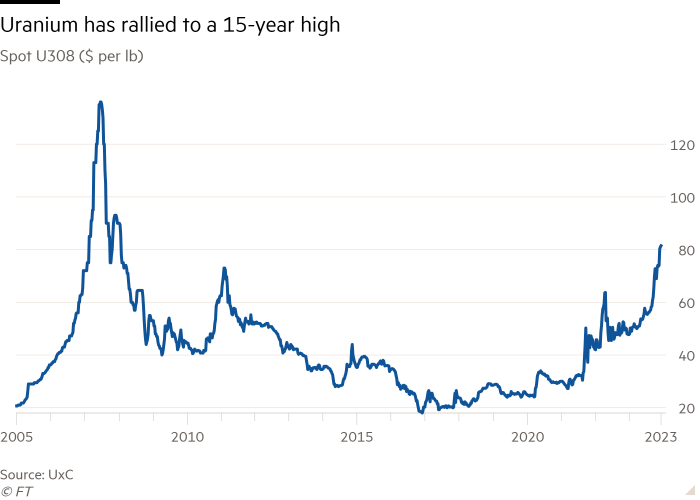China uranium grab poses threat to western energy supply, warns Yellow Cake

Roula Khalaf, Editor of the FT, selects her favourite stories in this weekly newsletter.
China is making an aggressive push to tie up global uranium supply amid a worldwide rush to secure nuclear fuel, warned the boss of Yellow Cake, a London-listed investment vehicle for the radioactive commodity.
André Liebenberg, chief executive of the Aim-traded company, said the west was lagging behind in securing uranium after prices hit a 15-year high and as Chinese firms purchase supplies on the open market, sign long-term contracts and buy up mines.
“Any mineral they need, they will look to tie up,” he said. “Chinese efforts to secure supply will certainly create competition for resources, and given resource opportunities are limited, they will challenge western utilities’ ability to source supply.”
Uranium has been one of the best-performing commodities of the year, climbing 70 per cent to trade at $81 per pound, its highest since 2007.
The blistering rally has been supported by governments supporting nuclear energy — a constant and low-carbon power source — by extending the lifetime of plants and considering building new reactors in the wake of gas prices skyrocketing last year.
At the UN’s recent COP28 climate conference in Dubai, 22 world leaders declared a commitment to treble nuclear capacity globally by 2050 compared with 2020 levels, further adding positive sentiment to an already boisterous market.
The price rise for the raw material has lifted Yellow Cake, which was founded in 2018 to give investors a way to gain exposure to an anticipated bull run for uranium. Liebenberg said there was a “decent chance” of the price breaking through $100 per pound next year.
After a decade of under-investment in new production and years of a supply glut following the global pullback in atomic power after the 2011 Fukushima nuclear disaster, uranium prices have returned to strength.
Yellow Cake has a 10-year supply agreement with Kazatomprom, the world’s largest producer of uranium, to buy $100mn of the mineral each year from the Kazakh company, which Yellow Cake then holds in storage facilities in Canada and France. At present, Yellow Cake holds the equivalent to almost 20 per cent of annual global supply.
Reflecting the surge in uranium prices, shares in Yellow Cake have rallied 54 per cent this year, taking its market capitalisation to £1.3bn. Last week the company said its net asset value had jumped from $1bn in March to $1.8bn as of early December.
To cash in, the company would either need to sell its holdings of uranium at higher prices than those at which it bought them or be taken over by a utility in need of supply.
China, the world’s second-largest producer of nuclear power, accounts for almost half the reactors under construction globally.
“The Chinese are running around looking for new supply,” Liebenberg said. “If they want to meet their nuclear plans by the end of the decade, then they will need new pounds.”

Beijing has set a goal of self-sufficiency in nuclear fuel through its goal of producing a third of its uranium needs domestically, obtaining another third via investment in foreign mines, and buying the remainder on the market.
China National Uranium Corporation and a subsidiary of CGN — China General Nuclear Power Group — have already taken equity in mines across Niger, Namibia and Kazakhstan, while CNUC is constructing a warehouse in Xinjiang next to the Kazakh border that aims to serve as a major uranium trading hub.
The drive by China to snap up supply adds to the headache that the west faces from relying on Russia, which controls almost 50 per cent of global uranium-enrichment capacity.
Liebenberg said that if Russia were to cut nuclear fuel supplies to the west, then utilities would face disruption in the five years that it would take to build a supply chain independent of Moscow.
Comments